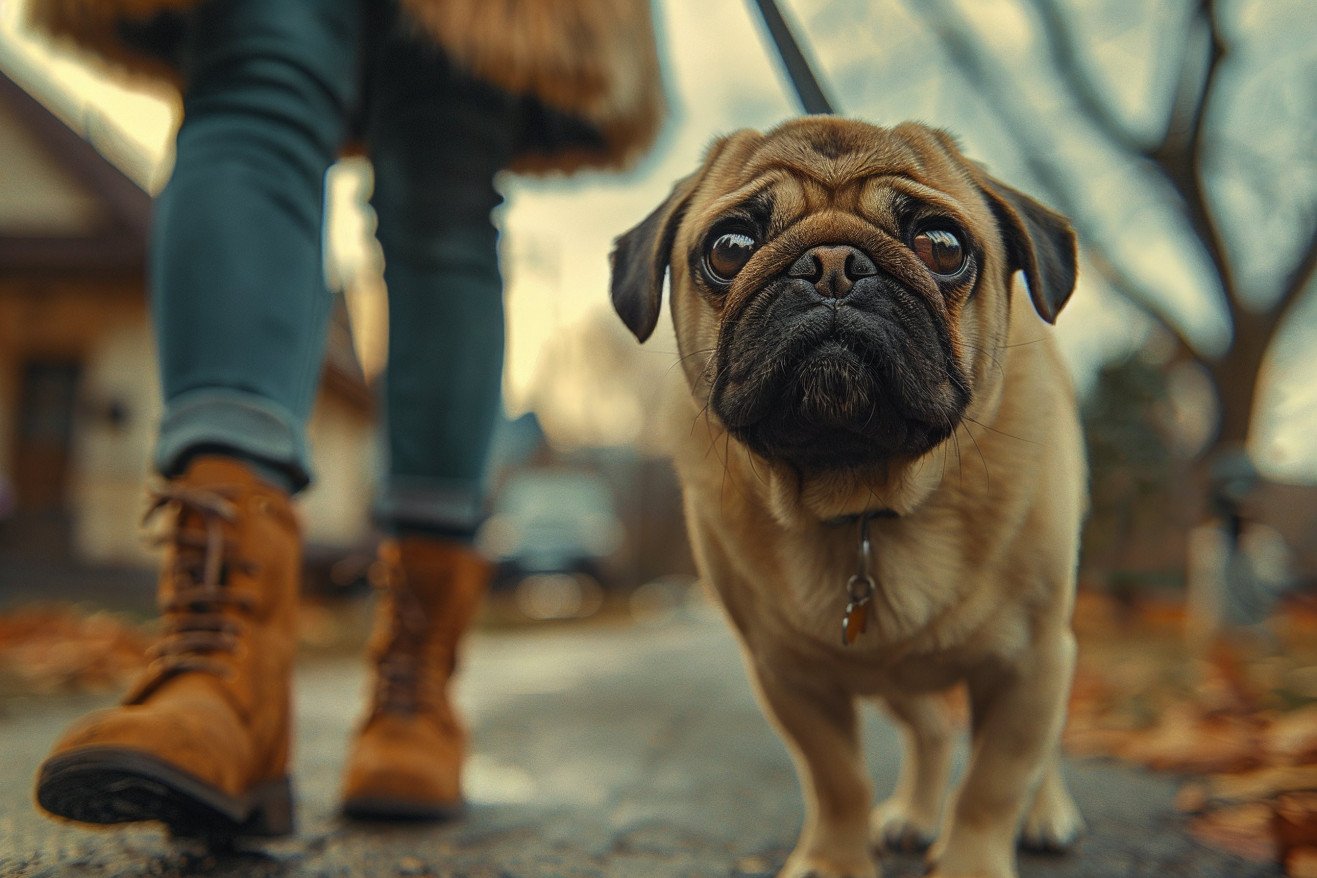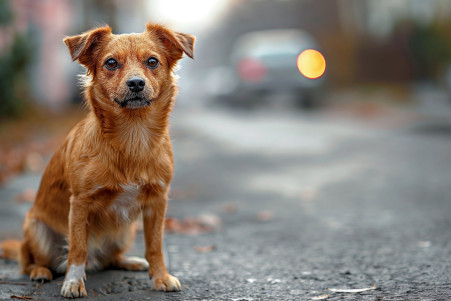How to Walk a Dog With Luxating Patella: Essential Guidelines
6 June 2024 • Updated 5 June 2024

Walking dogs with luxating patella is generally okay, but there are some things to keep in mind and some precautions to take when planning their exercise. Dogs with luxating patella, a condition where the kneecap shifts out of place, can be walked but should avoid high-impact activities like running or jumping. Leash walks on level ground are recommended, along with limiting exercise duration and intensity to prevent irritating the unstable kneecap.
The extent to which you should walk a dog with luxating patella will depend on the severity of their condition, which can range from mild to severe. We'll go over the advice of veterinarians when it comes to how much and what kind of exercise is appropriate for dogs with this condition. This will cover how to adjust your walking routine to your dog's individual needs and the best ways to modify their walks to help them avoid pain and injury in the long run. With the right care, many dogs with luxating patella can continue to walk and be active.
How should you walk a dog with luxating patella?
How Serious Is Luxating Patella?
The seriousness of luxating patella in dogs is often determined by a grading system that goes from 1 to 4, with 1 being the least severe and 4 being the most severe. According to the PDSA, cases that are considered mild (grades 1 and 2) can often be treated without surgery and instead be managed with physiotherapy and exercise. On the other hand, more serious cases (grades 3 and 4) will require surgery.
Grade 1 luxating patella means that the kneecap can be manually luxated but then goes back to its normal position when it's released. Grade 2 is characterized by intermittent luxation, which means that the kneecap moves in and out of place. Cornell University explains that these grades may not show clinical signs or lameness.
If a dog has grade 3 luxating patella, the kneecap is permanently luxated but can be manually replaced. Dogs at this grade will show signs of pain, lameness, and difficulty walking. In grade 4, the kneecap is permanently luxated and can't be manually replaced, which results in a loss of mobility.
It's important to diagnose the condition early, as Bond Vet points out, to prevent the condition from progressing and causing joint damage or arthritis. A vet will need to evaluate the dog and conduct a physical exam, and in some cases, imaging to determine the grade of the luxation and whether or not surgery or non-surgical treatment is the best course of action. Catching the condition early will help ensure that the dog's mobility and quality of life are maintained.
Exercise Recommendations for Dogs with Luxating Patella
Low-impact exercise, such as walking on a leash on flat terrain, is important for dogs with luxating patella. PDSA explains that high-impact activities like running, jumping, and playing fetch should be avoided because they can cause the kneecap to dislocate more.
Dr. Buzby's ToeGrips for Dogs suggests that you start with short walks and increase the time and distance as tolerated and recommended by your vet. This kind of controlled exercise can help make sure that your dog's muscles stay strong and that the joint stays healthy, which is important when it comes to managing luxating patella.
Some dogs may also benefit from other low-impact exercises, like hydrotherapy or underwater treadmill therapy. WaterWalkies explains that the water's buoyancy and resistance can help strengthen the muscles and increase the range of motion in the knees without putting too much pressure on them.
Surgery for Luxating Patella
Surgery is often necessary for dogs with more severe luxating patella, typically grades 3 and 4, to stabilize the patella and prevent further damage to the joint. TopDog Health explains that common surgical procedures include tibial tuberosity transposition, which involves the surgeon breaking and repositioning the tibial crest to realign the patellar tendon, and trochleoplasty procedures that deepen the trochlear groove to help the patella stay in place.
The Back Mountain Veterinary Hospital states that lateral imbrication, which tightens the joint capsule on the outside of the knee, is often performed in conjunction with other procedures. In some cases, it may also be necessary to address abnormal bone shapes in the femur or tibia to fully correct the causes of the luxation.
No matter which surgery is performed, the Veterinary Specialty Center says that it's important for dogs to undergo post-operative physical therapy and a slow return to activity under the care of a veterinarian to ensure that the joint heals properly and regains its function. Risks and complications can include infection, problems with the implants, and even the return of the luxation, so it's important to work with a board-certified veterinary surgeon to create a treatment plan that's tailored to the dog's needs.
Coping With Arthritis in Dogs with Luxating Patella
Arthritis is a common side effect of luxating patella in dogs because the condition can cause joint damage and inflammation over time. VCA Animal Hospitals explains that osteoarthritis, which is the inflammation and degeneration of one or more joints, is often associated with dogs that have congenital joint abnormalities like luxating patellas.
In order to cope with arthritis in dogs with luxating patella, it's important to focus on maintaining a healthy weight and low-impact exercise. CareCredit explains that it's important to let dogs grow slowly as puppies and keep them at a lean body condition to help prevent osteoarthritis. They also explain that controlled physical activity is important, as are potential treatments like joint supplements, pain medications, and physical therapy.
The Canine Arthritis Resource & Education Service explains that a variety of treatments are often used to manage arthritis, including medications, alternative treatments like laser therapy, and in more severe cases, joint replacement surgery. It's important to work with a vet to come up with a treatment plan that works for the dog, is tailored to their needs, and helps maintain their mobility and quality of life.
Luxating Patella in Dogs: Long-Term Issues and Prognosis
Overall, the prognosis for dogs with luxating patella is good, and many affected dogs can go on to live normal, active lives with the right care and treatment. One study published in PMC found that the incidence of medial patellar luxation in small breed dogs is 12 times higher than in large breed dogs. However, Zoetis Petcare reports that in the past decade, there has been an increase in the number of larger breed dogs diagnosed with the condition.
The key to a better long-term prognosis is early intervention and treatment. The study from PubMed noted that while surgical correction of grade IV medial patellar luxation was 93% successful overall, the rate of complications was high, with 24% of stifle joints experiencing major complications and 21% requiring revision surgery. This highlights the importance of ongoing care and monitoring after surgery to prevent complications or reluxation.
Regular veterinary care and follow-up appointments are important to help ensure the dog's mobility and quality of life. Zoetis Petcare explains that many dogs with luxating patella can have a good quality of life with proper care and treatment, even though the condition can be challenging to manage.
Conclusion: How to Keep Dogs Active With Luxating Patella
The risk of luxating patella is different for each dog breed. The American College of Veterinary Surgeons notes that patellar luxations are most common in toy and small breeds, including Boston Terriers, Yorkshire Terriers, Maltese, Bichon Frise, Chihuahuas, Pomeranians, and Toy Poodles, and are likely due to genetic factors. However, in the last decade, the organization has seen an increase in the number of patellar luxation cases in medium and large breeds, including Shiba Inu, Chinese Shar-Pei, Flat-Coated Retriever, Akita, and Great Pyrenees.
While patellar luxation cannot be prevented, good physical condition through appropriate exercise and weight management can help prevent the development of arthritis. That said, dogs with patellar luxation should not engage in strenuous exercise, as it can make the condition worse. The American College of Veterinary Surgeons also advises against breeding dogs with patellar luxation because the condition is hereditary.
With time, dedication, and a willingness to stick to a plan, pet parents can help their dogs overcome the obstacles that come with this manageable condition and live their best lives.


